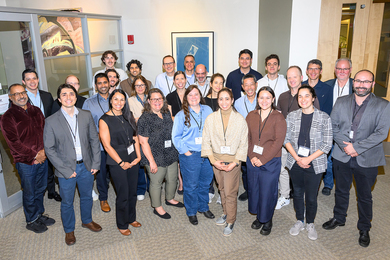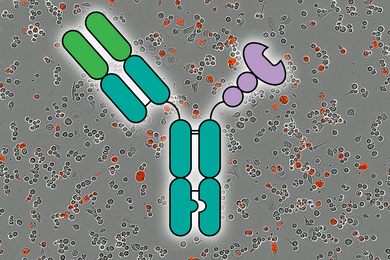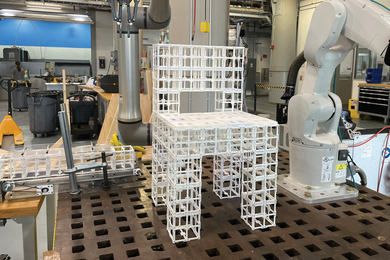All MIT offices charged with providing services and oversight to the Institute community on environmental, health and safety (EHS) matters have been reorganized into a single EHS team reporting to Jamie Lewis Keith, who is managing director for environmental programs and risk management and also MIT's senior counsel. The EHS team will provide improved service to MIT and create clearer accountability than was possible under a more fragmented organization.
MIT community members now have a single phone number to call for environmental health and safety services: x2-EHSS. The new number is one of the more visible changes resulting from the consolidation of three offices with sometimes overlapping responsibilities and shared jurisdiction as well as different reporting structures. This, combined with the absence of a single manager with overall EHS authority, had created some confusion for departments, labs and centers and inadequate accountability of these services.
Another less visible but very important result of the reorganization will be the clearer responsibility and accountability for EHS issues.
"This consolidation of areas is part of a continuing effort to bring together and align closely related activities and to clarify who is responsible for what," Executive Vice President John R. Curry said.
The portion of the Safety Office that dealt with environmental compliance and hazardous materials has been broken out of the Safety Office to create the new Environmental Management Office (EMO), to raise responsibility for environmental management issues to an equal level with safety and health issues.
The Safety Office will concentrate on fire safety, accident prevention and emergency response, as well as confined space rescue, pressure vessels and miscellaneous safety concerns. Gerald Diaz will continue to direct the Safety Office.
The Environmental Medical Service (EMS) manages the portion of environmental health and safety that concerns industrial hygiene, biosafety and radiation protection.
These three offices are now operating as the EHS team under Ms. Keith's Environmental Programs Office. The team is responsible for every environmental, health and safety regulatory program governing MIT's work.
When community members phone x2-EHSS, they will be calling on the team for services, support and oversight on environmental health and safety issues, without the burden of figuring out which office within the team has responsibility for a particular issue. People in labs and centers who already have a contact person should continue to call on him or her for help and advice.
RATIONALE
There are several reasons for having a more coordinated approach to environmental health and safety services at MIT. The Institute's wide range of research programs means that it must comply with many more regulations than most other universities face. And the number and complexity of these regulations has been growing steadily.
Two years ago, the Environmental Protection Agency inspected about 25 percent of MIT's labs and research centers and noted that the Institute did not have a clear delineation of roles, responsibilities and accountability for compliance. Nor was there a centralized management system or organization.
"The number one priority in this reorganization is client service," Ms. Keith said. "For example, with EHS's cross-training initiative and consolidation of legally required regulatory training programs over the coming year, every lab visit made and every regulatory training program offered by the team will provide service and assistance on a full range of environmental health and safety issues. It will be the EHS team's job, not the MIT community's responsibility, to find the right person for assistance on any EHS issue."
In addition to serving labs and centers, the EHS team will represent MIT in dealing with regulatory authorities. The team also will be responsible for working with representatives of faculty, administrative departments and students to develop and implement an environmental management system for the Institute that will integrate EHS initiatives with education and compliance and create a more comprehensive systems approach to EHS management.
In addition, the EHS team will work with the Environmental Programs Task Force, a group of representatives across MIT convened by Ms. Keith last fall, to coordinate positive environmental initiatives on campus (see related story on this page).
NEW JOB TITLES
With the reorganization come new titles for three key leaders. William Van Schalkwyk, formerly deputy director of the Safety Office and environmental compliance manager, is now director of the Environmental Management Office.
Dr. Robert McCunney will serve as EMS's director for occupational medicine, policy and education, coordinating efforts in those three areas. He dealt with these issues on a national level as past president of the American College of Occupational and Environmental Medicine.
"I feel very strongly about the importance of the EHS team maintaining close ties to MIT Medical," Ms. Keith said. "And Dr. McCunney, along with Dr. David Diamond, an MIT Medical physician, will continue to see employees, faculty and staff who need occupational and/or environmental medicine evaluations at MIT Medical."
Lou DiBerardinis has become acting director of operations and administration at EMS, as well as continuing his role as Institute industrial hygiene officer. In his new position, he will be responsible for all of EMS's operations, budget and staff. "This is an important role that requires excellent leadership, client service, technical and administrative skills," Ms. Keith said.
A version of this article appeared in MIT Tech Talk on July 12, 2000.





